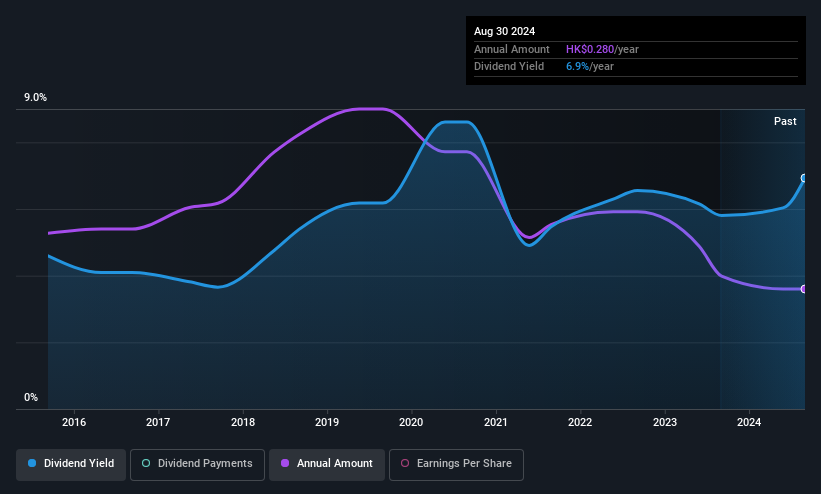- Hong Kong
- /
- Real Estate
- /
- SEHK:194
Do These 3 Checks Before Buying Liu Chong Hing Investment Limited (HKG:194) For Its Upcoming Dividend

Regular readers will know that we love our dividends at Simply Wall St, which is why it's exciting to see Liu Chong Hing Investment Limited (HKG:194) is about to trade ex-dividend in the next four days. The ex-dividend date is commonly two business days before the record date, which is the cut-off date for shareholders to be present on the company's books to be eligible for a dividend payment. The ex-dividend date is of consequence because whenever a stock is bought or sold, the trade can take two business days or more to settle. Thus, you can purchase Liu Chong Hing Investment's shares before the 26th of May in order to receive the dividend, which the company will pay on the 6th of June.
The company's next dividend payment will be HK$0.17 per share. Last year, in total, the company distributed HK$0.28 to shareholders. Based on the last year's worth of payments, Liu Chong Hing Investment stock has a trailing yield of around 6.8% on the current share price of HK$4.12. We love seeing companies pay a dividend, but it's also important to be sure that laying the golden eggs isn't going to kill our golden goose! We need to see whether the dividend is covered by earnings and if it's growing.
Our free stock report includes 2 warning signs investors should be aware of before investing in Liu Chong Hing Investment. Read for free now.Dividends are usually paid out of company profits, so if a company pays out more than it earned then its dividend is usually at greater risk of being cut. Liu Chong Hing Investment paid a dividend last year despite being unprofitable. This might be a one-off event, but it's not a sustainable state of affairs in the long run. Considering the lack of profitability, we also need to check if the company generated enough cash flow to cover the dividend payment. If Liu Chong Hing Investment didn't generate enough cash to pay the dividend, then it must have either paid from cash in the bank or by borrowing money, neither of which is sustainable in the long term. Fortunately, it paid out only 36% of its free cash flow in the past year.
See our latest analysis for Liu Chong Hing Investment
Click here to see how much of its profit Liu Chong Hing Investment paid out over the last 12 months.

Have Earnings And Dividends Been Growing?
When earnings decline, dividend companies become much harder to analyse and own safely. If business enters a downturn and the dividend is cut, the company could see its value fall precipitously. Liu Chong Hing Investment was unprofitable last year and, unfortunately, the general trend suggests its earnings have been in decline over the last five years, making us wonder if the dividend is sustainable at all.
Another key way to measure a company's dividend prospects is by measuring its historical rate of dividend growth. Liu Chong Hing Investment's dividend payments per share have declined at 3.5% per year on average over the past 10 years, which is uninspiring. While it's not great that earnings and dividends per share have fallen in recent years, we're encouraged by the fact that management has trimmed the dividend rather than risk over-committing the company in a risky attempt to maintain yields to shareholders.
Remember, you can always get a snapshot of Liu Chong Hing Investment's financial health, by checking our visualisation of its financial health, here.
The Bottom Line
Is Liu Chong Hing Investment an attractive dividend stock, or better left on the shelf? It's hard to get used to Liu Chong Hing Investment paying a dividend despite reporting a loss over the past year. At least the dividend was covered by free cash flow, however. It's not an attractive combination from a dividend perspective, and we're inclined to pass on this one for the time being.
Having said that, if you're looking at this stock without much concern for the dividend, you should still be familiar of the risks involved with Liu Chong Hing Investment. For example, Liu Chong Hing Investment has 2 warning signs (and 1 which doesn't sit too well with us) we think you should know about.
A common investing mistake is buying the first interesting stock you see. Here you can find a full list of high-yield dividend stocks.
If you're looking to trade Liu Chong Hing Investment, open an account with the lowest-cost platform trusted by professionals, Interactive Brokers.
With clients in over 200 countries and territories, and access to 160 markets, IBKR lets you trade stocks, options, futures, forex, bonds and funds from a single integrated account.
Enjoy no hidden fees, no account minimums, and FX conversion rates as low as 0.03%, far better than what most brokers offer.
Sponsored ContentNew: AI Stock Screener & Alerts
Our new AI Stock Screener scans the market every day to uncover opportunities.
• Dividend Powerhouses (3%+ Yield)
• Undervalued Small Caps with Insider Buying
• High growth Tech and AI Companies
Or build your own from over 50 metrics.
Have feedback on this article? Concerned about the content? Get in touch with us directly. Alternatively, email editorial-team (at) simplywallst.com.
This article by Simply Wall St is general in nature. We provide commentary based on historical data and analyst forecasts only using an unbiased methodology and our articles are not intended to be financial advice. It does not constitute a recommendation to buy or sell any stock, and does not take account of your objectives, or your financial situation. We aim to bring you long-term focused analysis driven by fundamental data. Note that our analysis may not factor in the latest price-sensitive company announcements or qualitative material. Simply Wall St has no position in any stocks mentioned.
About SEHK:194
Liu Chong Hing Investment
An investment holding company, engages in the investment, development, sale, management, and letting of properties in Hong Kong, the People’s Republic of China, the United Kingdom, and Thailand.
Fair value with mediocre balance sheet.
Market Insights
Community Narratives




